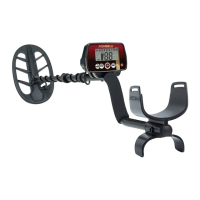9
16
TARGET IDENTIFICATION
Target-ID
When metal objects are detected, the detector will emit a sound, a Target-ID
Category icon will illuminate and a 2-digit Target-ID number will appear on the
screen. Possible Target-ID numbers range from 1 to 99. This number
represents the electrical conductivity of the target; higher numbers indicate
more highly conductive targets.
Target indicators on the screen only represent the last object detected. This
detector has fast target response and is able to detect different objects in very
close proximity. Therefore, the Target-ID displayed may change rapidly as you
sweep the searchcoil.
Three seconds after a target is detected, the ID numbers will time-out and
disappear and the Target Category Icon will change to the non-illuminated state.
Iron, Gold and Silver Indicators:
The group border momentarily flashes
when an object in that group is present.
The border flashes independently of the notch settings.
Relic hunters will frequently seek out iron-laden sites as good prospective
treasure-hunting sites. The iron indicator alerts the user to the presence of
iron, even if iron has been discriminated out. Relic hunters can search free of
iron-target audio, yet still be alerted to the presence of ferrous objects or
search with no discrimination and use the FeTone™ feature to decrease the
Audio Volume of ferrous targets.
4-Tone Target Identification
The detector will provide 1 of 4 sounds
for any metal object detected: a bass,
low, medium or high tone. This audio
feedback system is useful in
conjunction with the visual Category
Icon system described above.
Ferrous, gold and silver targets will generally register within their
corresponding category icon ranges. Targets that are not gold or silver register
within the same range according to their electrical conductivity. Note that the
electrical conductivity of a target depends on both its composition and size.
Silver is more conductive than gold so it registers farther to the right; and the
larger the silver object, the farther it registers to the right. There are a wide
variety of metals and no target can be identified for certain until unearthed.
See coin reference table on page 17.
Gold
Range
Silver
Range
Iron
Range
Target Conductivity Bar
IRON FOIL 5¢ ALUM Zn 10¢ 25¢ 50¢ $1
Iro
n Gold Silver
Fe 2 3 4 5 6 7 8 9
Iron Foil Nickel Alum Zn Dime Qtr Half Dollar
Jewelry Bass Med Med Med Med Hi Hi Hi Hi
Coin Bass Bass Med Bass Low Hi Hi Hi Hi
Artifact Bass Med Med Med Med Hi Hi Hi Hi
Custom User denable default VCO
THE BASICS OF METAL DETECTING
This metal detector is intended for locating buried metal objects. When
searching for metals, underground or on the surface, you have the following
challenges and objectives:
1. Ignoring signals caused by ground minerals.
2. Ignoring signals caused by metal objects that you do not want to find,
like nails.
3. Identifying a buried metal object before you dig it up.
4. Estimating the size and depth of objects, to facilitate digging them up.
5. Eliminating the effects of electromagnetic interference from other
electronic devices.
Your metal detector is designed with these things in mind.
1. Ground Minerals
All soils contain minerals. Signals from ground minerals can interfere with
the signals from metal objects you want to find. All soils differ and can differ
greatly in the type and amount of ground minerals present. This detector
has proprietary circuitry to automatically eliminate interfering signals from
minerals that occur naturally in the ground.
NOTE: This detector will not completely eliminate interference from all
types of minerals. For example, the detector IS NOT designed for use on
wet sand saltwater beaches. Another example of soil this detector will not
eliminate is any soil containing large concentrations of iron oxides, which
are usually red in color.
2. Trash
If searching for coins, you want to ignore items like aluminum foil and nails.
You can see the Target-ID of the buried objects, listen to the sounds and
then decide what you want to dig up. Or, you can eliminate unwanted
metals from detection by using the different Modes or NOTCH feature or
use the Custom mode to create your own discrimination settings.
3. Identifying Buried Objects
Metal objects are identified along the 9-segment Conductivity graphic symbols
and with a large 2-digit target ID number in the center of the screen. Both are
indicators of the relative electrical conductivity of different objects. Segments to
the right indicate more conductive targets. Iron objects will be illuminated with the
Fe symbol. The Fe (iron) category will display target ID numbers from 1 to 19.
Gold, nickel and brass objects will be illuminated in the
“Gold” group .
Silver and copper objects will be illuminated in the
“Silver” group .
4. Size and Depth of Buried Objects
The 3-segment graphic indicates the relative depth of a buried metal object.
This graphic can indicate the relative size of different objects or their
distance from the searchcoil. For a given object, the more distance
between it and the searchcoil, the more segment lines illuminated.

